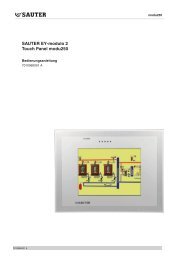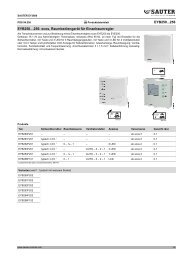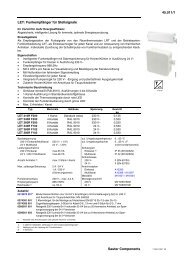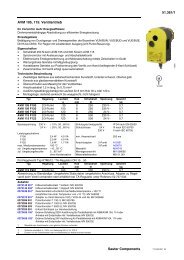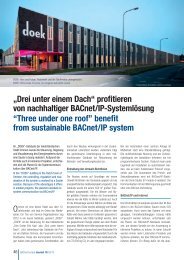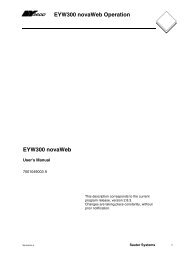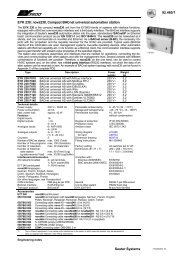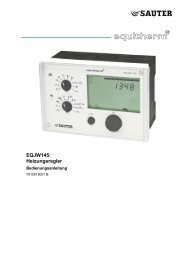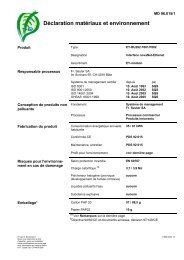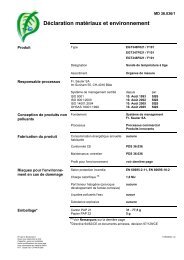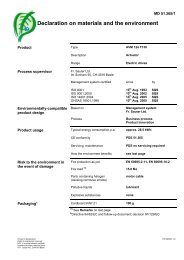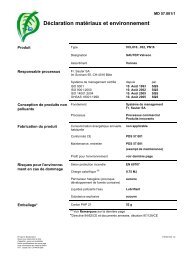novaPro Open 3.0 - sauter-controls.com sauter-controls.com
novaPro Open 3.0 - sauter-controls.com sauter-controls.com
novaPro Open 3.0 - sauter-controls.com sauter-controls.com
Create successful ePaper yourself
Turn your PDF publications into a flip-book with our unique Google optimized e-Paper software.
<strong>novaPro</strong> <strong>Open</strong> <strong>3.0</strong><br />
21CFR11 Compliance Statement<br />
7010069003<br />
This description corresponds to the<br />
current program version <strong>3.0</strong>. Changes<br />
may be made at any time without prior<br />
notice.<br />
7010069003
<strong>novaPro</strong> <strong>Open</strong><br />
<br />
2/32 7010069003
<strong>novaPro</strong> <strong>Open</strong><br />
Inhalt<br />
Inhalt<br />
1 Purpose 5<br />
2 Documents of Reference From: 7<br />
3 <strong>novaPro</strong> <strong>Open</strong> <strong>3.0</strong> position 9<br />
3.1 Introduction to <strong>novaPro</strong> <strong>Open</strong>‘s User Management concept 9<br />
3.2 Implementation of the Access Rights in a project 12<br />
3.3 Implementation of the Access Rights on Microsoft and Web level 16<br />
4 FDA 21 CFR 11 - Subpart A 17<br />
4.1 General Provisions 17<br />
4.1.1 Sec. 11.1 Scope 17<br />
4.1.2 Sec. 11.2 Implementation 18<br />
4.1.3 Sec. 11.3 Definitions 18<br />
5 FDA 21 CFR 11 - Subpart B 21<br />
5.1 Electronic Records 21<br />
5.1.1 Sec. 11.10 Controls for closed systems 21<br />
5.1.2 Sec. 11.30 Controls for open systems 25<br />
5.1.3 Sec. 11.50 Signature manifestations 26<br />
5.1.4 Sec. 11.70 Signature/record linking 27<br />
6 FDA 21 CFR 11 - Subpart C 29<br />
6.1 Electronic Signatures 29<br />
6.1.1 Sec. 11.100 General requirements 29<br />
6.1.2 Sec. 11.200 Electronic signature <strong>com</strong>ponents and <strong>controls</strong> 30<br />
6.1.3 Sec. 11.300 Controls for identification co-des/passwords 31<br />
7010069003<br />
3/32
<strong>novaPro</strong> <strong>Open</strong><br />
Inhalt<br />
4/32 7010069003
<strong>novaPro</strong> <strong>Open</strong><br />
Purpose<br />
1<br />
Purpose<br />
This document describes the <strong>novaPro</strong> <strong>Open</strong> <strong>3.0</strong> <strong>com</strong>pliance with the Food and<br />
Drugs Administration‘s Code of Federal Regulations, chapter 21, part 11 (aka.<br />
FDA 21 CFR 11).<br />
All text in italics is excerpted from the official FDA documentation.<br />
<strong>novaPro</strong> <strong>Open</strong> is a software suite providing a full set of tools to develop and<br />
deploy applications for Web-based Supervision, Control and Data Acquisition<br />
(SCADA) functionality as well as PC-Based Control operations. The design and<br />
development of the application and its <strong>com</strong>pliance with the initial requirements or<br />
any sort of regulations remains the responsibility of the application developer and<br />
does not transfer to SAUTER.<br />
FDA <strong>com</strong>pliance embraces <strong>com</strong>plete systems including hardware, software,<br />
documentation, files & user management, user’s rules of conduct, <strong>com</strong>pany<br />
security standards etc. Given that <strong>novaPro</strong> <strong>Open</strong> is only one element in this<br />
system, SAUTER (or any other SCADA software provider) cannot solely guarantee<br />
<strong>com</strong>pliance; this is dependent upon the environment in which it is deployed.<br />
However, SAUTER guarantees that, provided the application is developed, deployed<br />
and used according to its own written guidelines, it will not in itself create<br />
any breaches of FDA <strong>com</strong>pliancy.<br />
7010069003<br />
5/32
<strong>novaPro</strong> <strong>Open</strong><br />
6/32 7010069003
<strong>novaPro</strong> <strong>Open</strong><br />
Documents of Reference From:<br />
2<br />
Documents of Reference From:<br />
http://www.accessdata.fda.gov/scripts/cdrh/cfdocs/cfcfr/CFRSearch.<br />
cfm?CFRPart=11&showFR=1<br />
TITLE 21<br />
FOOD AND DRUGS<br />
CHAPTER I<br />
FOOD AND DRUG ADMINISTRATION, DEPARTMENT OF HEALTH AND<br />
HUMAN SERVICES<br />
PART 11<br />
GENERAL PROVISION<br />
ELECTRONIC RECORDS<br />
ELECTRONIC SIGNATURES<br />
Contents:<br />
Subpart A: General Provisions<br />
11.1 Scope.<br />
11.2 Implementation.<br />
11.3 Definitions.<br />
Subpart B: Electronic Records<br />
11.10 Controls for closed systems.<br />
11.30 Controls for open systems.<br />
11.50 Signature manifestations.<br />
11.70 Signature/record linking.<br />
Subpart C: Electronic Signatures<br />
11.100 General requirements.<br />
11.200 Electronic signature <strong>com</strong>ponents and <strong>controls</strong>.<br />
11.300 Controls for identification codes/passwords.<br />
7010069003<br />
7/32
<strong>novaPro</strong> <strong>Open</strong><br />
Documents of Reference From:<br />
8/32 7010069003
<strong>novaPro</strong> <strong>Open</strong><br />
<strong>novaPro</strong> <strong>Open</strong> <strong>3.0</strong> position<br />
3<br />
3.1<br />
<strong>novaPro</strong> <strong>Open</strong> <strong>3.0</strong> position<br />
Introduction to <strong>novaPro</strong> <strong>Open</strong>‘s User Management concept<br />
As required by FDA21 CFR11.200.1, <strong>novaPro</strong> <strong>Open</strong> employs two distinct<br />
identification <strong>com</strong>ponents such as a unique <strong>com</strong>bination of password and login.<br />
7010069003<br />
9/32
<strong>novaPro</strong> <strong>Open</strong><br />
Furthermore, there are several levels of security access used to control access to<br />
<strong>novaPro</strong> <strong>Open</strong>:<br />
• Users must be created by an administrator<br />
• Users can be requested to enter their own password upon first login<br />
• Users can be forced to change their password after a specific amount of time<br />
• Rules on the content (a <strong>com</strong>bination of letters, numbers and special symbols)<br />
and length of passwords can be applied<br />
• Users can be disallowed from using again their old passwords once their<br />
current password has expired<br />
• Upon 3 consecutive failed login attempts, an alarm is sent to all <strong>novaPro</strong> <strong>Open</strong><br />
on the network, thereby warning other users of potential security breaches.<br />
Actions to take upon such an alarm can be configured<br />
• User will be automatically logged out after a defined period of inactivity<br />
• A system of shift management can be used to control the times during which a<br />
user is allowed to login to the system<br />
• Users or groups can be granted or revoked access permission to station<br />
10/32 7010069003
<strong>novaPro</strong> <strong>Open</strong><br />
<strong>novaPro</strong> <strong>Open</strong> <strong>3.0</strong> position<br />
In order to ensure that only authorized user can access the system, strong<br />
authentication process can be put in place. Up to 3 user authentication mechanisms<br />
can be <strong>com</strong>bined for enhanced security:<br />
• Password and login<br />
• Biometric login (finger print)<br />
• Smartcard login<br />
7010069003<br />
11/32
<strong>novaPro</strong> <strong>Open</strong><br />
3.2<br />
Implementation of the Access Rights in a project<br />
Access control to all alarms, tags, objects in images and menu items can<br />
be controlled via options available when defining the application. It is the<br />
responsibility of the application designer to ensure that the correct options are<br />
selected.<br />
Access rights of a project can be defined for both Users and/or Groups of Users<br />
as described in the topics listed below.<br />
(a.) Access Rights for Tags<br />
It is possible for each Tag to define Users and/or Groups of Users that are<br />
allowed to access this Tag. Below is an example of such a configuration where<br />
ONLY Administrators and Operator1 have the right to access this Tag.<br />
12/32 7010069003
<strong>novaPro</strong> <strong>Open</strong><br />
<strong>novaPro</strong> <strong>Open</strong> <strong>3.0</strong> position<br />
(b.) Access Rights for Alarms<br />
It is possible for each defined Alarm to define Users and/or Groups of Users<br />
that are allowed to acknowledge this Alarm. Below is an example of such a<br />
configuration where ONLY Administrators and Operator1 have the right to<br />
acknowledge this Alarm.<br />
7010069003<br />
13/32
<strong>novaPro</strong> <strong>Open</strong><br />
<strong>novaPro</strong> <strong>Open</strong> <strong>3.0</strong> position<br />
(c.) Access Rights for Menus and Modules<br />
<strong>novaPro</strong> <strong>Open</strong> allows an extensive Access Rights configuration of the different<br />
modules and menu items. Below is an example of such a configuration where<br />
ONLY Administrators and Operator1 have the right to elaborate a Layer in an<br />
Image.<br />
(d.) Access Rights for Objects in Images<br />
Any object in an image can be defined to be accessible by specific Users and/<br />
or Groups of Users ONLY.<br />
In order to set up such an environment, <strong>novaPro</strong> <strong>Open</strong> provides access-right<br />
limited Layers on which the objects are placed. The default layer on an image<br />
is „BASE“.<br />
Below is an example where a new Layer „ADMIN_LAYER“ is created and its<br />
access limited to Operator1 and Administrators ONLY.<br />
14/32 7010069003
<strong>novaPro</strong> <strong>Open</strong><br />
<strong>novaPro</strong> <strong>Open</strong> <strong>3.0</strong> position<br />
To link an object to a specific layer, the layer must be first activated and the<br />
object then sent to this active layer.<br />
Below is an example of a Valve sent to the previously created „ADMIN_<br />
LAYER“<br />
Any logged operator who is either member of the „Administrators“ Group or<br />
who is „Operator1“ will see the previously configured layer and all of its object.<br />
Any logged operator that is not member of the „Administrators“ Group nor is<br />
„Operator1“ will not have access to the previously configured layer and will<br />
thus not see the objects on this layer.<br />
7010069003<br />
15/32
<strong>novaPro</strong> <strong>Open</strong><br />
<strong>novaPro</strong> <strong>Open</strong> <strong>3.0</strong> position<br />
3.3<br />
Implementation of the Access Rights on Microsoft and Web level<br />
<strong>novaPro</strong> <strong>Open</strong>‘s internal user management system can be linked to directly<br />
interact with the Windows security system, thereby controlling the level of access<br />
for a user to the actual PC. This allows, for instance, a user to have access only<br />
to <strong>novaPro</strong> <strong>Open</strong> and no other programs that may be installed on the system.<br />
Users and groups definition can be imported from Active Directory into <strong>novaPro</strong><br />
<strong>Open</strong> user management database. Active Directory is then in charge of user<br />
authentication for imported users. This feature also enables users to login into<br />
<strong>novaPro</strong> <strong>Open</strong> using their smartcards. The user will be logged out of <strong>novaPro</strong><br />
<strong>Open</strong> when the smartcard is removed. Smartcard authentication is handled<br />
natively by Windows and <strong>novaPro</strong> <strong>Open</strong> takes advantage of this support. This<br />
functionality enhances overall security.<br />
If it is decided to implement the active directory user management mechanism<br />
for general access limitation, it remains the sole responsibility of the system<br />
integrator or customer‘s IT department to configure, manage and maintain these<br />
settings.<br />
Please note that access to <strong>novaPro</strong> <strong>Open</strong> is available via the intranet or internet<br />
using a standard web browser such as Internet Explorer. The same system<br />
of User Management as defined in <strong>novaPro</strong> <strong>Open</strong> applies to any operator<br />
connecting thru a WebClient.<br />
SAUTER is not responsible for any security breach associated with the Operating<br />
System or with the browser itself.<br />
Implementation of adequate Firewalls, Antivirus and Networks are under the<br />
responsibility of the System Integrator or End user.<br />
16/32 7010069003
<strong>novaPro</strong> <strong>Open</strong><br />
FDA 21 CFR 11 - Subpart A<br />
4<br />
4.1<br />
4.1.1<br />
FDA 21 CFR 11 - Subpart A<br />
General Provisions<br />
Sec. 11.1 Scope<br />
(a.) The regulations in this part set forth the criteria under which the agency<br />
considers electronic records, electronic signatures, and handwritten signatures<br />
executed to electronic records to be trustworthy, reliable, and generally<br />
equivalent to paper records and handwritten signatures executed on paper.<br />
(b.) This part applies to records in electronic form that are created, modified,<br />
maintained, archived, retrieved, or transmitted, under any records requirements<br />
set forth in agency regulations. This part also applies to elec-tronic records<br />
submitted to the agency under requirements of the Federal Food, Drug, and<br />
Cosmetic Act and the Public Health Service Act, even if such records are not<br />
specifically identified in agency regulations. However, this part does not apply to<br />
paper records that are, or have been, transmitted by electronic means.<br />
(c.) Where electronic signatures and their associated electronic records meet the<br />
requirements of this part, the agency will consider the electronic signatures to<br />
be equivalent to full handwritten signatures, initials, and other general signings<br />
as required by agency regulations, unless specifically excepted by regulation(s)<br />
effective on or after August 20, 1997.<br />
(d.) Electronic records that meet the requirements of this part may be used in lieu<br />
of paper records, in accordance with 11.2, unless paper records are specifically<br />
required.<br />
(e.) Computer systems (including hardware and software), <strong>controls</strong>, and attendant<br />
documentation maintained under this part shall be readily available for,<br />
and subject to, FDA inspection.<br />
(f.) This part does not apply to records required to be established or maintained<br />
by 1.326 through 1.368 of this chapter. Records that satisfy the requirements of<br />
part 1, subpart J of this chapter, but that also are required under other applicable<br />
statutory provisions or regulations, remain subject to this part.<br />
7010069003<br />
17/32
<strong>novaPro</strong> <strong>Open</strong><br />
FDA 21 CFR 11 - Subpart A<br />
4.1.2<br />
Sec. 11.2 Implementation<br />
(a.) For records required to be maintained but not submitted to the agency,<br />
persons may use electronic records in lieu of paper records or electronic<br />
signatures in lieu of traditional signatures, in whole or in part, provided that the<br />
requirements of this part are met.<br />
(b.) For records submitted to the agency, persons may use electronic records in<br />
lieu of paper records or electronic signatures in lieu of traditional signatures, in<br />
whole or in part, provided that:<br />
(1.) The requirements of this part are met; and<br />
(2.) The document or parts of a document to be submitted have been<br />
identified in public docket No. 92S-0251 as being the type of submission the<br />
agency accepts in electronic form. This docket will identify specifically what<br />
types of documents or parts of documents are acceptable for submission in<br />
electronic form without paper records and the agency receiving unit(s) (e.g.,<br />
specific center, office, division, branch) to which such submissions may be<br />
made. Documents to agency receiving unit(s) not specified in the public<br />
docket will not be considered as official if they are submitted in electronic<br />
form; paper forms of such documents will be considered as official and<br />
must ac<strong>com</strong>pany any electronic records. Persons are expected to consult<br />
with the intended agency receiving unit for details on how (e.g., method of<br />
transmission, media, file formats, and technical protocols) and whether to<br />
proceed with the electronic submission.<br />
4.1.3<br />
Sec. 11.3 Definitions<br />
(a.) The definitions and interpretations of terms contained in section 201 of the<br />
act apply to those terms when used in this part.<br />
(b.) The following definitions of terms also apply to this part:<br />
(1.) Act means the Federal Food, Drug, and Cosmetic Act (secs. 201-<br />
903 (21 U.S.C. 321-393)).<br />
(2.) Agency means the Food and Drug Administration.<br />
(3.) Biometrics means a method of verifying an individual‘s identity<br />
based on measurement of the individual‘s physical feature(s) or repeatable<br />
action(s) where those features and/or actions are both unique to that<br />
individual and measurable.<br />
(4.) Closed system means an environment in which system access is<br />
controlled by persons who are responsible for the content of electronic records<br />
that are on the system.<br />
18/32 7010069003
<strong>novaPro</strong> <strong>Open</strong><br />
FDA 21 CFR 11 - Subpart A<br />
(5.) Digital signature means an electronic signature based upon<br />
cryptographic methods of originator authentication, <strong>com</strong>puted by using a set<br />
of rules and a set of parameters such that the identity of the signer and the<br />
integrity of the data can be verified.<br />
(6.) Electronic record means any <strong>com</strong>bination of text, graphics, data,<br />
audio, pictorial, or other information representation in digital form that<br />
is created, modified, maintained, archived, retrieved, or distributed by a<br />
<strong>com</strong>puter system.<br />
(7.) Electronic signature means a <strong>com</strong>puter data <strong>com</strong>pilation of any<br />
symbol or series of symbols executed, adopted, or authorized by an individual<br />
to be the legally binding equivalent of the individual‘s handwritten signature.<br />
(8.) Handwritten signature means the scripted name or legal mark of<br />
an individual handwritten by that individual and executed or adopted with<br />
the present intention to authenticate a writing in a permanent form. The act<br />
of signing with a writing or marking instrument such as a pen or stylus is<br />
preserved. The scripted name or legal mark, while conventionally applied to<br />
paper, may also be applied to other devices that capture the name or mark.<br />
(9.) <strong>Open</strong> system means an environment in which system access is<br />
not controlled by persons who are responsible for the content of electronic<br />
records that are on the system.<br />
7010069003<br />
19/32
<strong>novaPro</strong> <strong>Open</strong><br />
FDA 21 CFR 11 - Subpart A<br />
20/32 7010069003
<strong>novaPro</strong> <strong>Open</strong><br />
FDA 21 CFR 11 - Subpart B<br />
5<br />
5.1<br />
FDA 21 CFR 11 - Subpart B<br />
Electronic Records<br />
SAUTER <strong>com</strong>pliance: following electronic records generated with a <strong>novaPro</strong><br />
<strong>Open</strong> HMI (Human Machine Interface) project falls under the scope of this<br />
regulation:<br />
• Historical data files: contain information on daily tag values<br />
• Historical alarm files: contain information on daily alarms<br />
• Audit trail files: contain information on user actions<br />
5.1.1<br />
Sec. 11.10 Controls for closed systems<br />
Persons who use closed systems to create, modify, maintain, or transmit<br />
electronic records shall employ procedures and <strong>controls</strong> designed to ensure<br />
the authenticity, integrity, and, when appropriate, the confidentiality of electronic<br />
records, and to ensure that the signer cannot readily repudiate the signed record<br />
as not genuine. Such procedures and <strong>controls</strong> shall include the following:<br />
(a.) Validation of systems to ensure accuracy, reliability, consistent intended<br />
performance, and the ability to discern invalid or altered records.<br />
SAUTER <strong>com</strong>pliance: SAUTER provides all tools for generation, development<br />
and maintenance of HMI (Human Machine Interface) projects.<br />
The design and construction of any project by use of SAUTER products as<br />
well as the verification of it‘s <strong>com</strong>pliance with the FDA requirements and its<br />
final validation remain the sole responsibility of the project designer, systems<br />
integrator and of the customer.<br />
(b.) The ability to generate accurate and <strong>com</strong>plete copies of records in both<br />
human readable and electronic form suitable for inspection, review, and copying<br />
by the agency. Persons should contact the agency if there are any questions<br />
regarding the ability of the agency to perform such review and copying of the<br />
electronic records.<br />
SAUTER <strong>com</strong>pliance: <strong>novaPro</strong> <strong>Open</strong> HMI provides specific viewers to<br />
display the data contained in following electronic records:<br />
• historical data<br />
• historical alarm<br />
• audit trail<br />
Printing capabilities to provide human readable outputs are also included in<br />
Sauter HMI.<br />
The historical data are stored in proprietary format and can be additionally<br />
stored in any ODBC <strong>com</strong>pliant relational Database format.<br />
7010069003<br />
21/32
<strong>novaPro</strong> <strong>Open</strong><br />
FDA 21 CFR 11 - Subpart B<br />
The historical alarm are stored in *.DBF (daily records) files. Additionally, with<br />
the WizLogger option, the historical alarm can be stored parallel in a SQL or<br />
Oracle database.<br />
The audit trail data are to be stored in any ODBC <strong>com</strong>pliant relational<br />
database format.<br />
It is possible to copy these data; however, it remains the sole responsibility of<br />
the user to ensure that these copies are accurate and <strong>com</strong>plete regarding to<br />
the original data.<br />
(c.) Protection of records to enable their accurate and ready retrieval throughout<br />
the records retention period.<br />
SAUTER <strong>com</strong>pliance: <strong>novaPro</strong> <strong>Open</strong> historical data are stored in proprietary<br />
format to avoid alteration and falsification. However, it remains the sole<br />
responsibility of the user to protect those files from being deleted, moved, and<br />
renamed or from any other actions which could harm the stored data.<br />
Data logged to ODBC <strong>com</strong>pliant relational database should be secured and<br />
stored for the appropriate retention period.<br />
It is re<strong>com</strong>mended to take advantage of Microsoft‘s integrated User<br />
Management to limit access rights to these files.<br />
It remains the sole responsibility of the user to implement reliable backup and<br />
restore procedures to ensure accurate and ready retrieval of these records<br />
throughout the retention period.<br />
(d.) Limiting system access to authorized individuals.<br />
SAUTER <strong>com</strong>pliance: <strong>novaPro</strong> <strong>Open</strong> provides an advanced user<br />
management defining access rights to the project as described in the Chapter<br />
3 of this document. As required by FDA21 CFR11.200.1, <strong>novaPro</strong> <strong>Open</strong><br />
employs two distinct identification <strong>com</strong>ponents such as a unique <strong>com</strong>bination<br />
of password and login.<br />
Regarding general access limitation to the Operating System, <strong>novaPro</strong><br />
<strong>Open</strong> also provides an advanced user management which directly interacts<br />
with Microsoft Windows security mechanism thus enabling the use of<br />
the HMI project ONLY. The use of the above feature is optional, general<br />
access limitation can also be achieved using Microsoft‘s integrated User<br />
Management. If it is decided to implement the standard Microsoft user<br />
management mechanism for general access limitation it remains the sole<br />
responsibility of the customer‘s IT department to configure, manage and<br />
maintain these settings.<br />
22/32 7010069003
<strong>novaPro</strong> <strong>Open</strong><br />
FDA 21 CFR 11 - Subpart B<br />
(e.) Use of secure, <strong>com</strong>puter-generated, time-stamped audit trails to independently<br />
record the date and time of operator entries and actions that create,<br />
modify, or delete electronic records. Record changes shall not obscure previously<br />
recorded information. Such audit trail documentation shall be retained for a<br />
period at least as long as that required for the subject electronic records and shall<br />
be available for agency review and copying.<br />
SAUTER <strong>com</strong>pliance: <strong>novaPro</strong> <strong>Open</strong> embeds natively a time stamped audit<br />
trail. In order to ensure secure audit trail records, it is re<strong>com</strong>mended to save<br />
audit trail data in a SQL database with security rules. It remains the sole<br />
responsibility of the customer‘s IT department to manage this database and<br />
to protect those files from being corrupted, damaged, deleted, moved, renamed<br />
or from any other actions which could harm the stored data. In case of<br />
MSSQL and records not being encrypted for this type of database, SAUTER<br />
re<strong>com</strong>mends activating the MSSQL AuditTrail feature in order to trace any<br />
manual changes to the records.<br />
Actions logged in <strong>novaPro</strong> <strong>Open</strong> audit trail are divided into three categories:<br />
• User actions in the HMI Project (e.g. user login or logout, changing a<br />
tag value, going to a zone, running a macro)<br />
• Group Management (e.g. create or delete a group, changing minimum<br />
password length, removing a user from a group)<br />
• User Management (e.g. create or delete a user, changing a user<br />
password, changing a user password expiration, changing user web<br />
rights)<br />
New records do not obscure previously recorded information in the audit trail<br />
database.<br />
All operations performed on alarms are also stored within the alarm historical<br />
file, with the user identification in term of action (acknowledgement, force<br />
end…).<br />
In order to ensure traceability, changing a tag value should only be made from<br />
the <strong>novaPro</strong> <strong>Open</strong> HMI Project and not from the studio.<br />
It remains the sole responsibility of the user to implement reliable backup and<br />
restore procedures to ensure accurate and ready retrieval of the audit trail<br />
documentation throughout the retention period.<br />
(f.) Use of operational system checks to enforce permitted sequencing of steps<br />
and events, as appropriate.<br />
SAUTER <strong>com</strong>pliance: enforcing permitted sequencing of steps and events,<br />
as appropriate, can be achieved by implementing sequential macros, actions<br />
on events and by designing steps as Image jumps. It remains the sole<br />
responsibility of the customer using these various methods to design its<br />
application in order to provide the appropriate operational systems checks.<br />
7010069003<br />
23/32
<strong>novaPro</strong> <strong>Open</strong><br />
FDA 21 CFR 11 - Subpart B<br />
(g.) Use of authority checks to ensure that only authorized individuals can use the<br />
system, electronically sign a record, access the operation or <strong>com</strong>puter system<br />
input or output device, alter a record, or perform the operation at hand.<br />
SAUTER <strong>com</strong>pliance: <strong>novaPro</strong> <strong>Open</strong> provides an advanced user<br />
management as described in the Chapter 3 of this document, defining access<br />
rights to the project modules (History viewers, menus, images, actions,<br />
Alarms…). In addition, station access restriction can be defined for each user<br />
or group.<br />
By implementing the user management from an Active Directory and using<br />
LDAP <strong>com</strong>munication protocol, it is possible to restrict access to <strong>com</strong>puter<br />
system input and output devices.<br />
(h.) Use of device (e.g., terminal) checks to determine, as appropriate, the validity<br />
of the source of data input or operational instruction.<br />
SAUTER <strong>com</strong>pliance: In addition of the „normal“ user login and password<br />
required, some installations require specific limitations for terminal. In practice<br />
there can be a limitation when using a Web Client in terms of terminals that<br />
are allowed to access the system.<br />
The simplest way to implement this limitation is to use a firewall listing the IP<br />
or MAC addresses of the allowed terminals and their actions. It remains the<br />
sole responsibility of the customer to choose, configure, manage and maintain<br />
these firewalls.<br />
(i.) Determination that persons who develop, maintain, or use electronic record/<br />
electronic signature systems have the education, training, and experience to<br />
perform their assigned tasks.<br />
SAUTER <strong>com</strong>pliance: <strong>novaPro</strong> <strong>Open</strong>‘s embedded user management<br />
consists of Users that are assigned to User Groups as described in the<br />
Chapter 3 of this document. Generally, access rights in projects are defined at<br />
a User Group level.<br />
It remains the sole responsibility of the customer to verify that the users<br />
configured as being member of a User Group will have the education, training,<br />
and experience that corresponds to the tasks assigned to this User Group.<br />
(j.) The establishment of, and adherence to, written policies that hold individuals<br />
accountable and responsible for actions initiated under their electronic<br />
signatures, in order to deter record and signature falsification.<br />
SAUTER <strong>com</strong>pliance: It is the sole responsibility of the customer to establish<br />
and maintain the adherence to such written policies.<br />
24/32 7010069003
<strong>novaPro</strong> <strong>Open</strong><br />
FDA 21 CFR 11 - Subpart B<br />
(k.) Use of appropriate <strong>controls</strong> over systems documentation including:<br />
(1.) Adequate <strong>controls</strong> over the distribution of, access to, and use of<br />
documentation for system operation and maintenance.<br />
SAUTER <strong>com</strong>pliance: The customer/systems integrator who has developed<br />
an application using <strong>novaPro</strong> <strong>Open</strong> is responsible for writing its own<br />
documentation and maintaining it.<br />
(2.) Revision and change control procedures to maintain an audit trail that<br />
documents time-sequenced development and modification of systems<br />
documentation.<br />
SAUTER <strong>com</strong>pliance: The customer/systems integrator who has developed<br />
an application using <strong>novaPro</strong> <strong>Open</strong> is responsible for applying revision and<br />
change control procedures for the system as well as for its documentation.<br />
5.1.2<br />
Sec. 11.30 Controls for open systems<br />
Persons who use open systems to create, modify, maintain, or transmit<br />
electronic records shall employ procedures and <strong>controls</strong> designed to ensure the<br />
authenticity, integrity, and, as appropriate, the confidentiality of electronic records<br />
from the point of their creation to the point of their receipt. Such procedures and<br />
<strong>controls</strong> shall include those identified in Sec. 11.10, as appropriate and additional<br />
measures such as document encryption and use of appropriate digital signature<br />
standards to ensure, as necessary under the circumstances, record authenticity,<br />
integrity, and confidentiality.<br />
SAUTER <strong>com</strong>pliance: <strong>novaPro</strong> <strong>Open</strong> is designed for CREATION and VIEWING<br />
of electronic records only.<br />
MODIFICATION, MAINTENANCE and TRANSMISSION of such records are not<br />
part of the scope of <strong>novaPro</strong> <strong>Open</strong>.<br />
The establishment of written procedures and <strong>controls</strong> to ensure the authenticity,<br />
integrity and, as appropriate, the confidentiality of electronic records from the<br />
point of their creation to the point of their receipt remains the sole responsibility of<br />
the customer.<br />
„Operator driven electrical records“ such as reports will be generated by <strong>novaPro</strong><br />
<strong>Open</strong> including the signature of the Operator liable for the document.<br />
7010069003<br />
25/32
<strong>novaPro</strong> <strong>Open</strong><br />
FDA 21 CFR 11 - Subpart B<br />
5.1.3<br />
Sec. 11.50 Signature manifestations<br />
(a.) Signed electronic records shall contain information associated with the<br />
signing that clearly indicates all of the following:<br />
(1.) The printed name of the signer;<br />
(2.) The date and time when the signature was executed; and<br />
(3.) The meaning (such as review, approval, responsibility, or authorship)<br />
associated with the signature.<br />
SAUTER <strong>com</strong>pliance: Signed electronic records such as events and alarms<br />
recorded in archives files by <strong>novaPro</strong> <strong>Open</strong> are written with the name of the<br />
user who has acknowledged the event or alarm with the date and time stamp<br />
of the acknowledgment. It is possible to document the meaning of the alarm<br />
acknowledgement by putting a <strong>com</strong>ment that can be displayed from the event<br />
summary (alarm history viewer).<br />
In addition, <strong>novaPro</strong> <strong>Open</strong> is providing an audit trail to record the time<br />
stamped actions performed by the operator.<br />
To include a meaning or any other <strong>com</strong>ment related to this action, a novaPLC<br />
program can be implemented to force the operator to enter his signature along<br />
with a <strong>com</strong>ment before being able to perform the action.<br />
Below is an example of such a novaPLC program:<br />
26/32 7010069003
<strong>novaPro</strong> <strong>Open</strong><br />
FDA 21 CFR 11 - Subpart B<br />
(b.) The items identified in paragraphs (a)(1), (a)(2), and (a)(3) of this section<br />
shall be subject to the same <strong>controls</strong> as for electronic records and shall be<br />
included as part of any human readable form of the electronic record (such as<br />
electronic display or printout).<br />
SAUTER <strong>com</strong>pliance: <strong>novaPro</strong> <strong>Open</strong> includes viewers that allow any signed<br />
electronic record (such as the signed record of an alarm acknowledgement<br />
or a signed record of an action in the audit trail) that will be part of a human<br />
readable document or display containing the items specified under (a)(1), (a)<br />
(2), and (a)(3).<br />
It is the project designer‘s responsibility to configure the standard viewers<br />
(event summary, audit trail…) in <strong>novaPro</strong> <strong>Open</strong> to include these items.<br />
5.1.4<br />
Sec. 11.70 Signature/record linking<br />
Electronic signatures and handwritten signatures executed to electronic records<br />
shall be linked to their respective electronic records to ensure that the signatures<br />
cannot be excised, copied, or otherwise transferred to falsify an electronic record<br />
by ordinary means.<br />
SAUTER <strong>com</strong>pliance: All electronic signatures and their respective records<br />
are stored either in proprietary formats to <strong>novaPro</strong> <strong>Open</strong> or in external, ODBC<br />
<strong>com</strong>pliant, relational databases.<br />
The definition of access rights to the possible relational databases and their<br />
maintenance (backups) remains the sole responsibility of the customer.<br />
7010069003<br />
27/32
<strong>novaPro</strong> <strong>Open</strong><br />
FDA 21 CFR 11 - Subpart B<br />
28/32 7010069003
<strong>novaPro</strong> <strong>Open</strong><br />
FDA 21 CFR 11 - Subpart C<br />
6<br />
6.1<br />
6.1.1<br />
FDA 21 CFR 11 - Subpart C<br />
Electronic Signatures<br />
Sec. 11.100 General requirements<br />
(a.) Each electronic signature shall be unique to one individual and shall not be<br />
reused by, or reassigned to, anyone else.<br />
SAUTER <strong>com</strong>pliance: All electronic signatures are <strong>com</strong>posed of a unique set<br />
of login and password.<br />
It is the customer‘s sole responsibility not to give an already used set of login/<br />
password to another or different operators.<br />
(b.) Before an organization establishes, assigns, certifies, or otherwise sanctions<br />
an individual‘s electronic signature, or any element of such electronic signature,<br />
the organization shall verify the identity of the individual.<br />
SAUTER <strong>com</strong>pliance: the verification of the operator‘s identity before<br />
establishment, assignment or certification of an electronic signature (login/<br />
password) is the sole responsibility of the customer.<br />
(c.) Persons using electronic signatures shall, prior to or at the time of such<br />
use, certify to the agency that the electronic signatures in their system, used<br />
on or after August 20, 1997, are intended to be the legally binding equivalent of<br />
traditional handwritten signatures.<br />
SAUTER <strong>com</strong>pliance: The certification to the agency by the person using<br />
electronic signature that this signature (login/password) are intended to be a<br />
legally binding equivalent to traditional handwritten signatures remains under<br />
the direct responsibility of the customer.<br />
(1.) The certification shall be submitted in paper form and signed with a<br />
traditional handwritten signature, to the Office of Regional Operations (HFC-<br />
100), 5600 Fishers Lane, Rockville, MD 20857.<br />
SAUTER <strong>com</strong>pliance: The submission in paper form of the certification to the<br />
Office of Regional Operations remains under the direct responsibility of the<br />
customer.<br />
(2.) Persons using electronic signatures shall, upon agency request, provide<br />
additional certification or testimony that a specific electronic signature is the<br />
legally binding equivalent of the signer‘s handwritten signature.<br />
SAUTER <strong>com</strong>pliance: Providing additional certification or testimony upon<br />
agency request remains under the direct responsibility of the customer.<br />
7010069003<br />
29/32
<strong>novaPro</strong> <strong>Open</strong><br />
FDA 21 CFR 11 - Subpart C<br />
6.1.2<br />
Sec. 11.200 Electronic signature <strong>com</strong>ponents and <strong>controls</strong><br />
(a.) Electronic signatures that are not based upon biometrics shall:<br />
(1.) Employ at least two distinct identification <strong>com</strong>ponents such as an<br />
identification code and password.<br />
SAUTER <strong>com</strong>pliance: <strong>novaPro</strong> <strong>Open</strong> employs two distinct identification<br />
<strong>com</strong>ponents such as a unique <strong>com</strong>bination of password and login.<br />
(i.) When an individual executes a series of signings during a single,<br />
continuous period of controlled system access, the first signing shall be<br />
executed using all electronic signature <strong>com</strong>ponents; subsequent signings shall<br />
be executed using at least one electronic signature <strong>com</strong>ponent that is only<br />
executable by, and designed to be used only by, the individual.<br />
SAUTER <strong>com</strong>pliance: in <strong>novaPro</strong> <strong>Open</strong>, the first and all subsequent signings<br />
are always <strong>com</strong>posed by the two identification <strong>com</strong>ponents (login/password).<br />
(ii.) When an individual executes one or more signings not performed<br />
during a single, continuous period of controlled system access, each signing<br />
shall be executed using all of the electronic signature <strong>com</strong>ponents.<br />
SAUTER <strong>com</strong>pliance: in <strong>novaPro</strong> <strong>Open</strong>, the first and all subsequent signings<br />
are always <strong>com</strong>posed by the two identification <strong>com</strong>ponents (login/password).<br />
(2.) Be used only by their genuine owners; and<br />
SAUTER <strong>com</strong>pliance: verification and certification that a unique <strong>com</strong>bination<br />
of identification <strong>com</strong>ponents is not used by different individuals is the sole<br />
responsibility of the customer.<br />
(3.) Be administered and executed to ensure that attempted use of an<br />
individual‘s electronic signature by anyone other than its genuine owner<br />
requires collaboration of two or more individuals.<br />
SAUTER <strong>com</strong>pliance: It is re<strong>com</strong>mended that the customer shall prohibit the<br />
use of an individual‘s electronic signature by anyone other than its genuine<br />
owner. Biometric authentication for access control can avoid the use of an<br />
individual‘s electronic signature by anyone other than its genuine owner.<br />
(b.) Electronic signatures based upon biometrics shall be designed to ensure that<br />
they cannot be used by anyone other than their genuine owners.<br />
30/32 7010069003
<strong>novaPro</strong> <strong>Open</strong><br />
FDA 21 CFR 11 - Subpart C<br />
SAUTER <strong>com</strong>pliance: <strong>novaPro</strong> <strong>Open</strong> authentication mechanisms can<br />
integrate biometry. However, the systems integrator is responsible for<br />
ensuring, during the user enrollment process, that the biometric feature (finger<br />
print), belongs to his genuine owner. In addition, the systems integrator is<br />
responsible for designing, developing and validating the system. It remains<br />
the sole responsibility of the customer to ensure that biometrics signatures are<br />
used by their genuine owner.<br />
6.1.3<br />
Sec. 11.300 Controls for identification co-des/passwords<br />
Persons who use electronic signatures based upon use of identification codes in<br />
<strong>com</strong>bination with passwords shall employ <strong>controls</strong> to ensure their security and<br />
integrity. Such <strong>controls</strong> shall include:<br />
(a.) Maintaining the uniqueness of each <strong>com</strong>bined identification code and<br />
password, such that no two individuals have the same <strong>com</strong>bination of<br />
identification code and password.<br />
SAUTER <strong>com</strong>pliance: <strong>novaPro</strong> <strong>Open</strong>’s user management mechanism<br />
prohibits the coexistence of identical sets of signature identification<br />
<strong>com</strong>ponents.<br />
(b.) Ensuring that identification code and password issuances are periodically<br />
checked, recalled, or revised (e.g., to cover such events as password aging).<br />
SAUTER <strong>com</strong>pliance: <strong>novaPro</strong> <strong>Open</strong>‘s user management mechanism<br />
includes a configurable password aging mechanism to ensure the periodical<br />
checking, recalling and revision of the identification code and password<br />
issuance.<br />
(c.) Following loss management procedures to electronically deauthorize lost,<br />
stolen, missing, or otherwise potentially <strong>com</strong>promised tokens, cards, and other<br />
devices that bear or generate identification code or password information,<br />
and to issue temporary or permanent replacements using suitable, rigorous<br />
<strong>controls</strong>.<br />
SAUTER <strong>com</strong>pliance: the implementation of such <strong>controls</strong> as to remove<br />
from the system or republish a <strong>com</strong>bination of signature <strong>com</strong>ponents that has<br />
be<strong>com</strong>e <strong>com</strong>promised remains the sole responsibility of the customer.<br />
(d.) Use of transaction safeguards to prevent unauthorized use of passwords<br />
and/or identification codes, and to detect and report in an immediate and<br />
urgent manner any attempts at their unauthorized use to the system security<br />
unit, and, as appropriate, to organizational management.<br />
7010069003<br />
31/32
SAUTER <strong>com</strong>pliance: definition of user passwords and identification codes<br />
are stored in a secured user management database and are encrypted.<br />
In addition, <strong>novaPro</strong> <strong>Open</strong> generates a system wide alarm upon the third<br />
failed login attempt. The configuration of an urgent reporting (per fax, E-mail,<br />
SMS…) linked to such an event and its possible subsequent actions (logout,<br />
locking of the station…) remains the sole responsibility of the project designer.<br />
(e.) Initial and periodic testing of devices, such as tokens or cards, that bear<br />
or generate identification code or password information to ensure that they<br />
function properly and have not been altered in an unauthorized manner.<br />
SAUTER <strong>com</strong>pliance: Initial and periodic testing plan of devices bearing<br />
or generating identification or password information remains the sole<br />
responsibility of the customer.<br />
© Fr. Sauter AG<br />
Im Surinam 55<br />
CH-4016 Basel<br />
Tel. +41 61 - 695 55 55<br />
Fax +41 61 - 695 55 10<br />
www.<strong>sauter</strong>-<strong>controls</strong>.<strong>com</strong><br />
info@<strong>sauter</strong>-<strong>controls</strong>.<strong>com</strong><br />
Printed in Switzerland



